Adolf Führer and his expensive weapon for an expensive country
People and weapon. It always has been and will be: somewhere there is an abundance of traditionalist people, and somewhere, on the contrary, rationalizers. And traditionalists hold on to the familiar, old, time-tested with their hands and teeth, but somewhere they can easily make changes. That is why in the armies of some countries, weapons serve for a long time, while in others new and more and more improved models appear with enviable regularity. And then there are people who, to their pleasure, use both of them. One offering the good old, the other - new and original. Who likes what! You just need to understand what kind of people you are dealing with, and then your business is in the hat. Again, the authority of the one who offers also plays a role. Well, perhaps the best confirmation of this fact is story with some weapons from a country like Switzerland. This country has not been at war for several centuries, but has a well-equipped army, and it is also an expensive country, so its inhabitants even prefer to buy “Swiss cheese” in neighboring France, and sausages in Germany. Going there by car and buying there is cheaper than buying at home. Such is the country, this Switzerland.
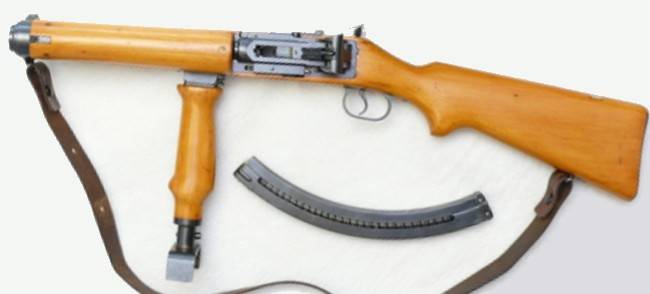
Submachine gun Adolf Führer MP1919 (Military Museum of the Walrus Castle, Lausanne)
And it was so that, although Switzerland itself did not participate in the First World War, it actively produced weapons and led the development of new models of it. And here is Adolf Führer, director of the government arms factory in Bern, which produced the famous Parabellum pistols, was no stranger to invention.
Based on the Parabellum with an elongated artillery barrel, he designed his own MP1919 submachine gun and aviation twin submachine gun for observers flying on reconnaissance aircraft. Both submachine guns had the same device, differing only in details: on the first, the 50 round magazine was located on the right, and on the “spark” - on top, which was due to the peculiarities of its placement in a cramped cockpit.
Both the one and the other sample went into small-scale production: MP1919 produced 92 copies, and by 19 the Doppelpistole-1921 factory produced 61 copies in Bern. They were sent to the aviation unit in Dubendorf. Where they were put on planes, but this design did not deserve special reverence due to the greater weight - 9,1 kg without cartridges. Actually, the "basic" model itself did not cause much enthusiasm. The fact is that Fuhrer, without further ado, simply took and put the Parabellum mechanism on his side, so that the locking lever system was on the left, and the store (so that soldiers could not grab it!) Was located on the right. The trunk was lengthened, the store was placed “aviation”, a wooden forend and a rifle butt were attached to a long trunk. And it turned out ... a submachine gun, which, the war lasted another year or two, could well compete with the famous Bergman MP1918. Why could you? Yes, because the need for such weapons would increase sharply, and those factories that made the "parabellum" would switch to the production of submachine guns, even more complex and expensive. But what did not happen did not happen.
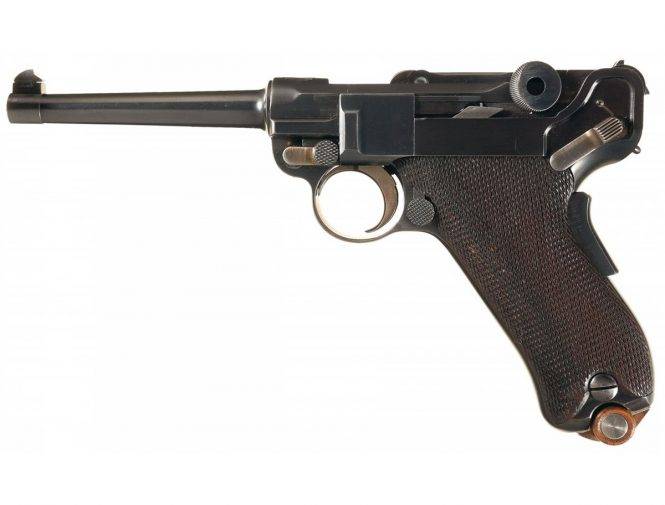
Swiss Luger 1900 (Military Museum of the Walrus Castle, Lausanne)
Moreover, when Switzerland itself needed submachine guns after the First World War, it did not continue to produce the MP1919, but adopted the very “Bergman” MP-18, which the SIG company began to produce. Model 1920 was produced from 1920 to 1927. It was MP.18 / I of Theodore Bergman. Moreover, the SIG Model 1920 was also called "Brevet Bergmann" because of the stigma on the neck of the store, which meant "Bergman's patent." The main difference was that the supply of cartridges did not come from a snail store, but from a two-row sector box store with 50 rounds. In the 1920 model, he adjoined the submachine gun on the left, but already in the 1930 model they began to install it on the right. SIG Model 1920 were delivered to Finland - chambered for 7,65x22 Luger, and were also exported to China and Japan - chambered for 7,63x25 Mauser. SIG Model 1930 was also sold abroad: traditionally high Swiss quality was the best advertisement not only for watches, but also for Swiss weapons.
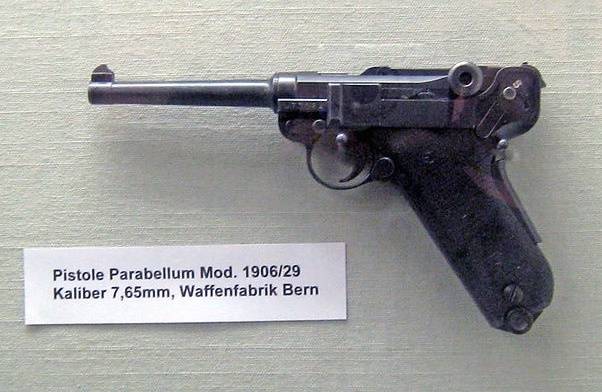
Swiss "Luger" Pistol M1906 / 29. Year 1944. A collection of weapons at the Reienthal Fortress Museum
In 1934, SIG also began production of the MKMS submachine gun and its shortened MKPS shortened version. The shutter on them was semi-free, the weapons turned out to be complex and expensive, so in 1937 they were replaced by outwardly similar SIG MKMO and MKPO models, but which already had a free shutter. The first folding shops along the forearm were used for the first time, which made the weapon more convenient to carry. The magazine opening in the receiver closed automatically, so that dust and dirt could not get inside through it. The fire mode was set by pressing the trigger. On the submachine gun "SIG MKMS" provided for the installation of a bayonet-knife. But in the case of the previous samples, they were not in special demand, so until 1941 they released only 1228 pieces, some of which were sold to Finland in 1939.
Well, and then the Second World War began, and, as was often the case in the past, the Swiss military suddenly found out that they actually did not have submachine guns in the army, but they were needed, as evidenced by the experience of military operations. Well, the MP-19 is already very outdated, and even released them too little. Therefore, in May 1940, the Swiss Military Technical Division (KTA) published a specification for the new design of the submachine gun. Due to the political situation in the country and the urgency of the order, only two companies were involved in the project: SIG and the government arsenal Waffenfabrik Bern (W + F). The latter was controlled by Colonel Adolf Führer, a highly respected man and constructor in the relevant circles of Switzerland. The reason for the rush was due to the fact that the Swiss intelligence received information about the German plan of Operation Tannenbaum ("Christmas Tree"), according to which 11 divisions of the Wehrmacht and about 500 Luftwaffe aircraft were allocated for the invasion of Switzerland. The Swiss counter-plan Operationsbefehl # 10 relied on rapid mobilization, a retreat to the alpine core of the country, and the conduct of a protracted land warfare accustomed to the actions of the Swiss infantry in the mountains, which was to force the Germans to agree to a truce. However, the military realized that this kind of conflict would require a large number of submachine guns in the troops.
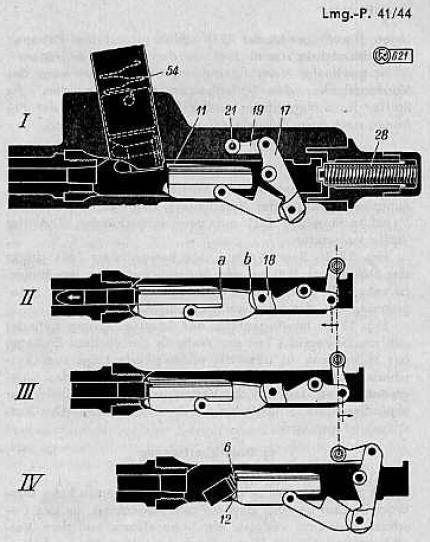
The action diagram of the lever shutter of the MP41 / 44 submachine gun
And here it should be noted that Führer was a clear supporter of the lever principle of Maxim's automation and saw in him the future of all firearms. A certain role in the formation of this conviction was played by the fact that the famous Parabellum by Georg Luger, chambered for 7,65 × 21 mm, was adopted by the Swiss army back in 1900! And the fact that its production was rather laborious did not bother anyone at that time. Although with a mass of 0,87 kg, 6,1 kg of metal was needed to make a pistol. That is, more than 5 kg of high-quality metal was converted into shavings! And the fabrication process itself required 778 separate operations, 642 of which were carried out on machine tools and 136 were carried out manually.
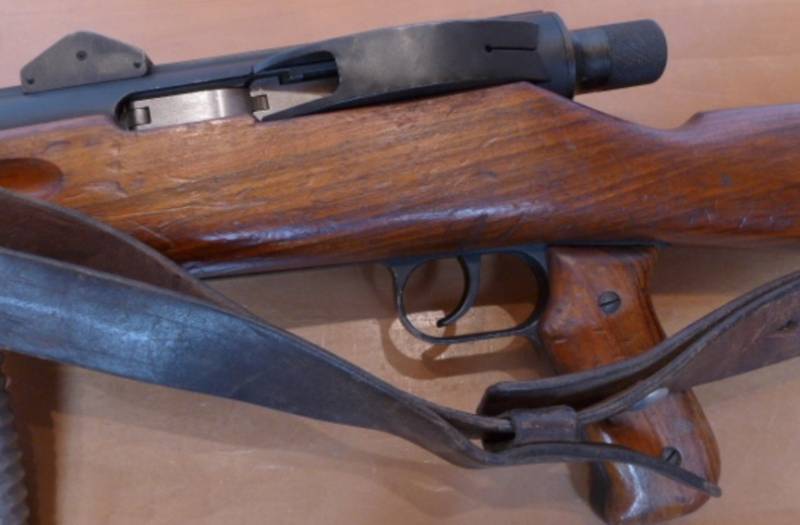
Bolt box of the MP41 / 44 submachine gun. The cutout is clearly visible in it for the free movement of the shutter levers and the protective cover in the back
A competition was organized, for which the MP41 model came from SIG, which became the logical development of the 1937 submachine gun. It was designed for a standard 9mm cartridge, powered by a 40-round box magazine. The shutter is free, it was a solid piece of forged steel. Rate of Fire 850 / min The SIG sample was almost ready for production, but the Fuerrer's sample (also MP41) was just a set of drawings and intermediate layouts showing how this or that part of the mechanism would work. And then ... Führer began to simply make fun of a competitor’s model, use his influence in political and military circles, promise that his submachine gun would be better, but the main thing he pressed on was the obvious advantages of the Luger pistol. All decision makers were officers who fired from this pistol. Everyone held it in their hands, everyone liked it, and now there is a man who offers to turn him into a submachine gun and, moreover, to begin production immediately. Naturally, there were more traditionalists among the Swiss military than innovators, and so they chose the Führer model. Another factor that determined this choice was the Lmg-25 light machine gun, also developed by Adolf Führer and put into service in 1925. The military had no complaints against him, and they felt that the submachine gun, created according to a similar scheme, would work just as well. And it was their opinion that turned out to be decisive, so that Führer defeated SIG solely because of the "existing opinion".
In fact, the MP 41 was extremely complex, without any special advantages over the much simpler submachine guns. In all respects, it also turned out to be worse than the SIG sample - it was harder to carry, the bullet speed was lower, and we could not even talk about complexity. Führer himself even went to the juggling of data: the weight of his machine gun gave without cartridges, and the company SIG - with cartridges! As a result, it turned out that his fully equipped specimen weighed more than 5 kg, that is, it was about as heavy as an infantry rifle. Rate of fire was 800 rds / min. The precision firing range was indicated at 200 yards (180 m), but it was actually less, especially in burst mode. The stock and the stock to reduce weight were first made from bakelite, but it cracked, and it had to be replaced with a tree. For the sake of convenience, a folding front handle was installed, which was held in place by an internal spring mount. The barrel had a ventilated casing to which a rather long bayonet could be attached.
The soldiers armed with MP 41/44 (as it began to be called after the modernization of 1944) relied on a unique bandoleer. These were two closed metal boxes, each of which contained three equipped stores. The boxes were spring loaded so that the stores did not rattle, which, unfortunately, only made it difficult to quickly remove them. All this was attached to the soldier with the help of a complex system of belts. Like the MP 41/44 itself, all this was much more complicated than required.
It is clear that if the system for locking the shutter at the Luger pistol worked, then it, even if laid on its side, should have worked in exactly the same way. But it is completely incomprehensible why it was necessary to do so when in the same Soviet PPS-43 everything was much simpler and cheaper with respect to mass production.
And it is not surprising that almost immediately after signing the contract with W + F, the Swiss army regretted its decision. The first 50 machines were made only in the summer of 1941, and their mass production began in the fall, half a year behind schedule. The MP 41/44 was incredibly expensive, and it took a long time to make it. By January 1942 (by that time the threat from Germany had already passed) only 150 copies were made, by August 1, 1943 - 2192, and by the New Year of 1944 - only 2749.
Finally realized that placing the store on the right side was a mistake. After all, most of the soldiers were right-handed; and on most submachine guns with horizontal magazines they are on the left, so the soldier’s right hand remains on the handle, and a weaker hand is involved in changing stores. With MP 41/44, a soldier had to either take it in his left hand or turn it over to charge with his left. In June 1944, after the release of the 5200th machine, the design was changed. The new version received the designation MP 41/44, but since almost all earlier samples were later modified, today this designation is used for all its variants as a whole.
A new rear sight, adjustable for 200 meters (218 yards), was installed on the submachine gun, and all plastic parts were made of wood. Production was completed in 1945 on the 9700th instance. Since the weapons were very expensive, in post-war Switzerland they decided to leave these submachine guns in service. A proposal was made to introduce a return spring tension regulator so that it would be more convenient for a soldier, for example, to shoot uphill and downhill, for example, from a mountain into a valley. But this complication of an already complex design was abandoned, since it was obvious that the soldiers could not really do this in the event of a real war.
In the meantime, SIG prepared a replacement model - MP 46. But the best, often the enemy of the good, and the project remained the project, and the Führer machine continued to serve. To sell it, by the way, also did not work, because in the arms market there were plenty of cheap American and English submachine guns left over from the war.
MP 41/44 were withdrawn from the army only in 1959-1960 and placed in warehouses. In 1970, they were declared completely obsolete and disposed of. As a result, they became a museum rarity, so in 2006, one active MP 41/44 was sold in the United States for $ 52. Today, even deactivated museum pieces cost $ 000 each. By the way, the Swiss themselves are very negative about the "episode" with MP 10/000 and do not like to remember about it!
But the colonel’s machine gun turned out to be quite good. Since 1925, when it was adopted by the army of the republic, it was used for a long time, until the late 1950s - early 1960s, when it was replaced by new automatic rifles Stgw. 57, firing the same cartridges, and with characteristics that were close to a light machine gun. Like many other Swiss-made weapon systems, the Furrer Lmg-25 (such was its full name) had high workmanship, excellent reliability, survivability, and precision, but also high cost.
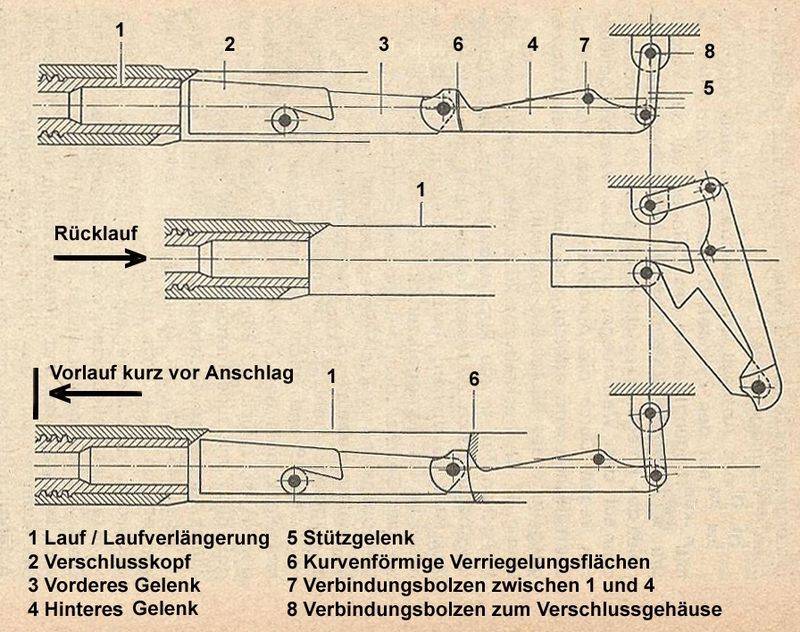
The action diagram of the shutter and locking levers on the machine gun Lmg-25
The machine gun Lmg-25 used automation, acting by the recoil force of the barrel with a short stroke. The shutter was locked by a pair of levers in the horizontal plane. But the Lmg-25 also had a third rod, which connected the rear lever of the locking assembly to the receiver, thereby achieving a constant kinematic connection of the bolt with the movable barrel, which should theoretically increase the reliability of its automation. However, a very high accuracy of fitting of all the rubbing parts, of which there were many in this design, was required. Sector box magazine 30 rounds adjoined on the right and had a through slot for visual control of ammunition consumption. Shot shells were thrown horizontally to the left. The cutout in the left wall of the receiver, in which the locking levers moved, was closed with a special dust cover in the stowed position. Machine gun barrel cooling - air. It was also possible to quickly replace it, but it was necessary to replace the entire bolt unit, since it was connected to the barrel with levers locking it. Shooting was carried out with the shutter open, when rolling out its moving parts, which reduced peak recoil values. The machine gun had a wooden pistol grip and a butt and a metal bipod folding bipod. Under the forearm or butt, you could install an additional handle or machine gun on an infantry tripod.
PS This machine gun was described in more detail on "VO" in an article by Kirill Ryabov "Machine gun W + F LMG25 (Switzerland)" dated February 17, 2016, it is only a pity that only one person commented on it then.
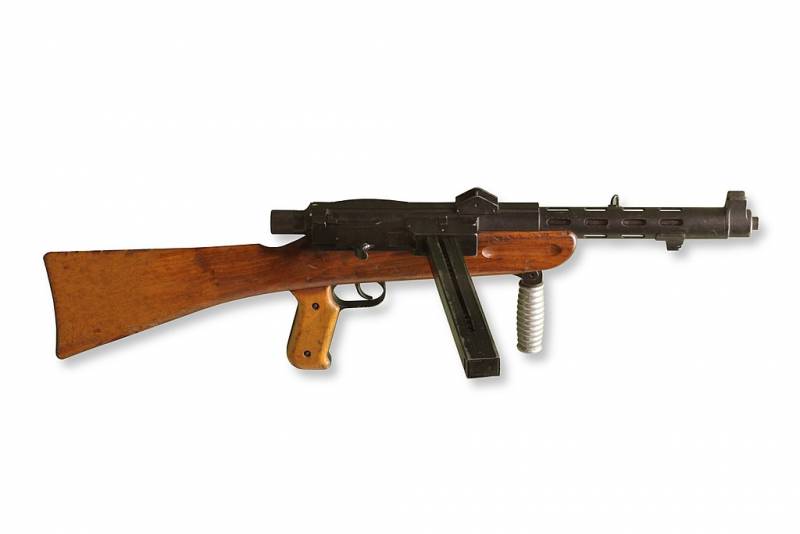
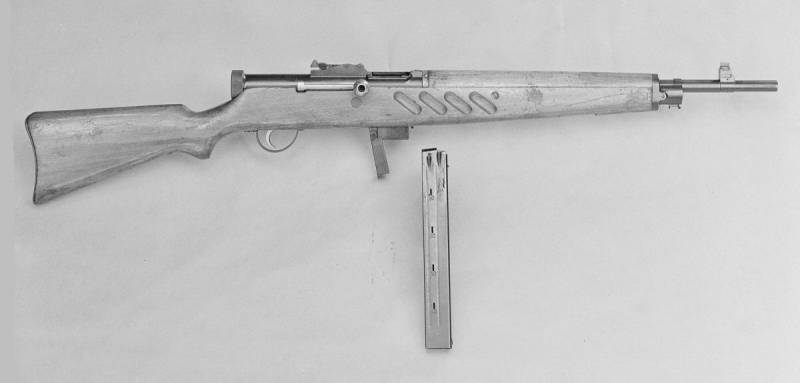
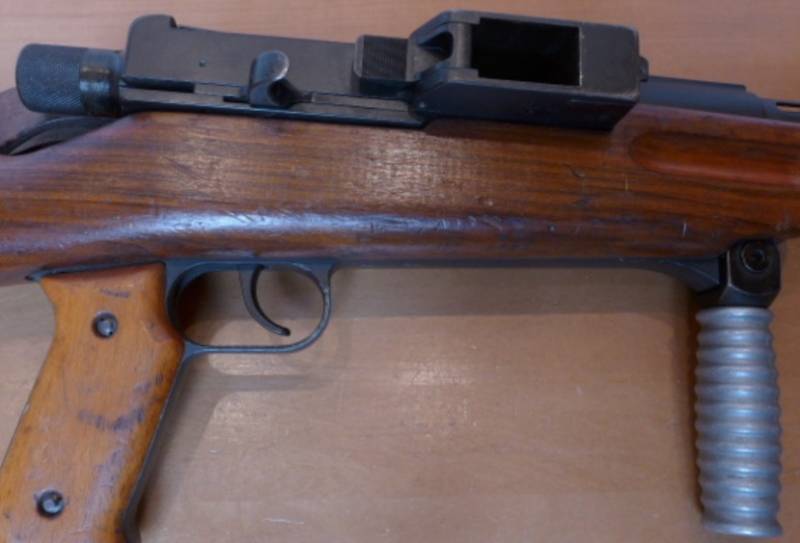

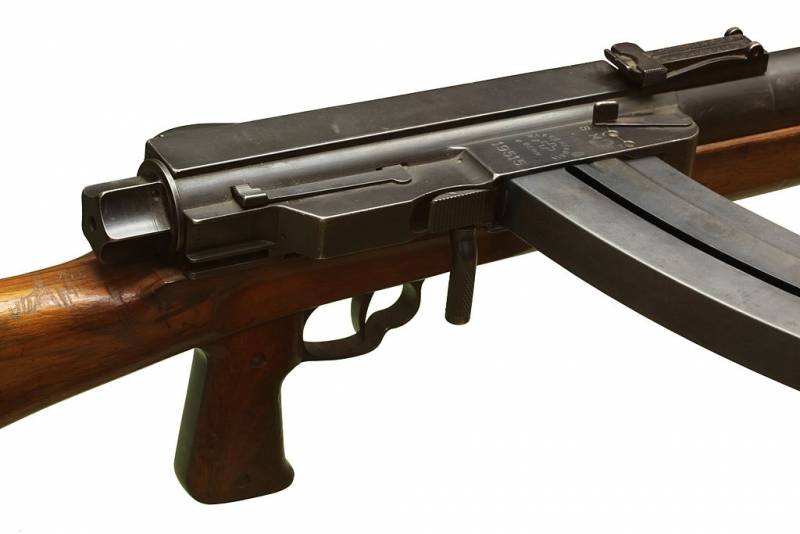
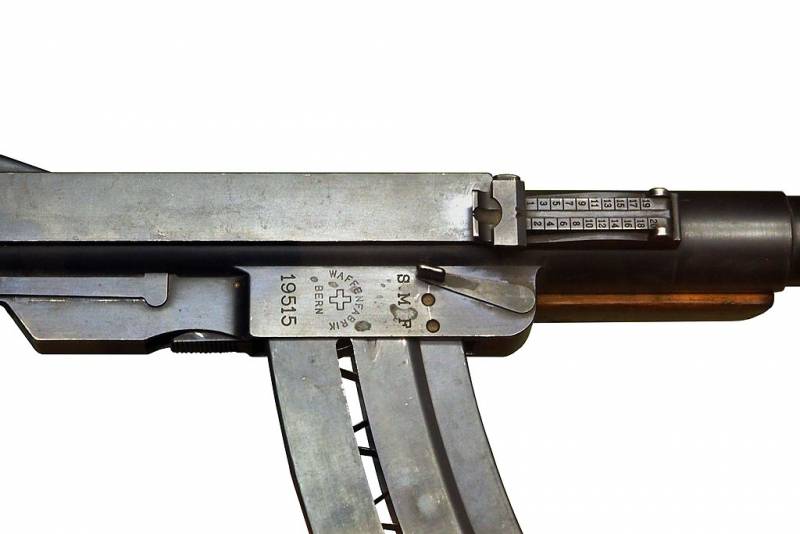
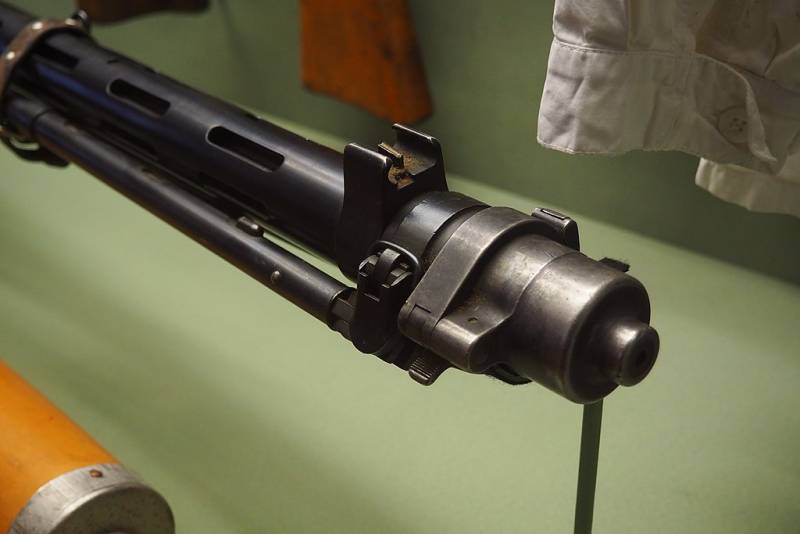
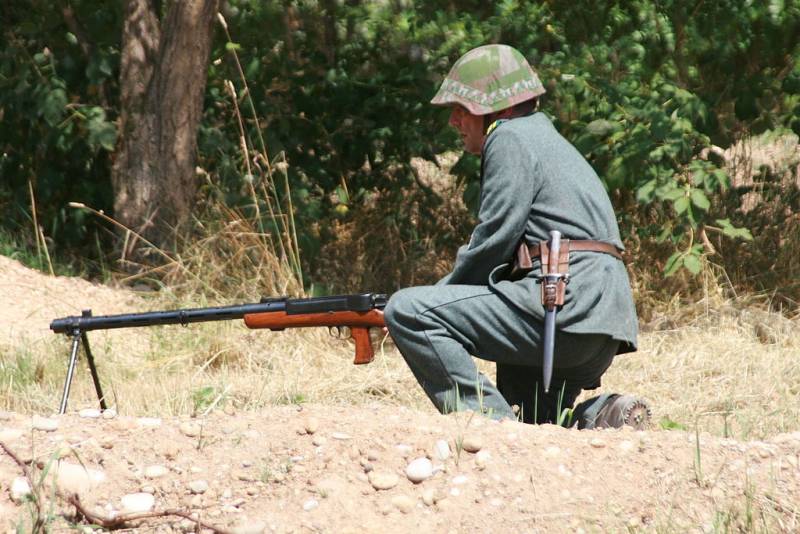
Information